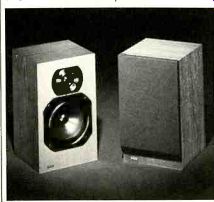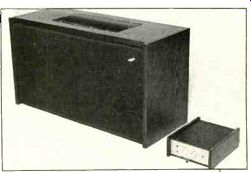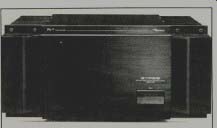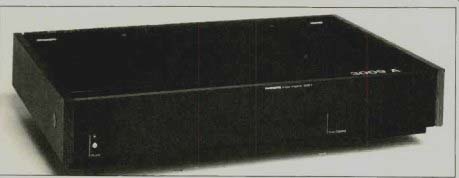SCENES STEALERS
Last month I reported on the considerable activity in new CD-player technology at the Winter Consumer Electronics Show in Las Ve gas. Herewith, a roundup of more conventional new audio equipment that I found interesting at the show.
As always, loudspeakers comprised the largest product category among the high-end audio exhibits. As I have noted in previous years, much of the sound I have heard at the Riviera Hotel is a sad indictment of most current speaker designs. With few ear-pleasing exceptions, this year's crop of loudspeakers were conspicuous by their lack of musicality. Even allowing for the admittedly poor acoustics of the Riviera demonstration rooms, too many of the loudspeakers I heard were woe fully inadequate in the simple matter of conveying a pleasing sound.
What is more frustrating is that when you gently point out to manufacturers various shortcomings in their transducers, they take considerable umbrage and think you are either a wise guy or some cranky old curmudgeon with tin ears and an axe to grind!
Among the noteworthy systems was an improved version of the Magneplanar MG-III panel loudspeaker. Driven by a Levinson ML-3 amplifier, the speakers were playing the wonderful Digital Music Products CD recording of "Trio." The transient attack of the piano was excellent, with a fine tonal verisimilitude. Bass response appeared to be more extended and better defined.
Dynamic range was certainly not constricted, and imaging was quite nicely presented. All in all, one of the best sounds at the Riviera.

----- B & W DM100 loudspeaker
Speaking of screen-type loudspeakers, it was good to see Acoustat back in business. As you may know, Acoustat had fallen on hard times and had filed for Chapter Eleven bankruptcy protection. Happily, they have been resurrected and are now under the banner of the resourceful David Hafler organization. The Acoustat plant, most of the original employees, and chief engineer Jim Strickland are all on track again and back in full production of their various electrostatic loudspeakers. Jim has come up with a major improvement applicable to all Acoustat loudspeakers, an innovative transformer known as the Acoustat Medallion.
The new transformer is said to increase dynamic range and give a warmer, smoother sound, while bass response is extended, with better control of bass' transients. Better transient response and the extended, high-frequency output are additional pluses, as are enhanced imaging and better retrieval of depth. The new Medallion transformer can be retrofitted to earlier Acoustat loudspeakers; the modifications are performed at the Acoustat factory in Fort Lauderdale, Fla. Acoustat loud speakers using the MK-121 full-range interface can be modified for $300 per pair, and those using the MK-131 sub-woofer interface will cost $225 per pair to modify. Anyone interested in these modifications should contact Acoustat directly. The Medallion transformer is used in the new Acoustat Model One, a single-panel electrostatic speaker standing 6 feet high. The Model One operates down to 100 Hz, and then an 18-inch cube subwoofer with a 10-inch, dual voice-coil driver takes over.
With the Medallion transformer, the Model One is said to have the output of the earlier two-panel design. SPL is rated at 108 dB measured at 15 feet in a 14 by 18-foot room. Price of the Mod el One, complete with subwoofer, is $1,195 per pair.

--- Duntech Thor subwoofer
Before leaving the realm of the electrostatic loudspeaker, you might be interested in an extensive and expensive ($2,000) modification to the Quad ESL 63 performed by Crosby Audio Works (101 First St., Suite 163, Los Altos, Cal. 94022). This modification, originally developed by Richard Fryer and Demian Martin of Spectral Audio, and CBS engineer Richard Lees, reworks the entire frame to add additional mass and thereby reduce resonances present in the stock frame. The 60 feet of internal wiring is replaced by wire de signed by Bruce Brisson of M.I.T. (and the designers suggest using the same wire for speaker cables). Proprietary Teflon and polystyrene capacitors and aerospace-quality resistors are used in the electronics section. A special grille cloth that is 40% more acoustically transparent than the OEM cloth is used. All of these modifications are said to provide better overall focus with reduced resonant colorations, in creased depth of field, and larger image size.
Infinity introduced four loudspeakers especially designed for video applications involving stereo sound. The VM 1, the premier model, features a 6 1/2-inch, long-throw woofer, a poly-dome midrange, and an EMIT tweeter. The unit is self-powered with a 60-watt amplifier for each channel. Volume, bass and treble controls are provided, as well as DNR noise reduction, and the speaker is magnetically shielded to prevent TV-picture distortion. Price of the VM-1 is $699 per pair. The VM-2 is a two-way, self-powered model with 40 watts per channel; its price is $479.
The VM-3, the same as the VM-2 but without amplifiers, is priced at $299 a pair, and the VM-4, a still smaller, non-powered unit, is $199 per pair. Need less to say, the powered VM-1 will probably be used for straightforward audio applications as well as for TV.
With more and more people living in apartments, small loudspeakers are becoming increasingly popular, especially the diminutive loudspeakers de signed with all the advantages of modern transducer technology and new materials. A case in point is the Wharfedale Diamond loudspeaker measuring 9 1/2 in. H x 7 1/2 in. W x 8 in. D. This tiny transducer employs a two-way reflex design with a reflex port firing rearwards. A 3/4-inch dome tweeter is combined with a 4 1/2-inch bass/ midrange driver; crossover is at 5 kHz.
The Diamond is designed to be played close to a wall, and this placement is said to provide bass response to 50 Hz. I thought the Diamond sounded very smooth, with good imaging, clean transients and a nice, open sound. Voices were particularly well reproduced, with good articulation. The Diamond is priced at $195 per pair.
B & W has also entered the small-loudspeaker sweepstakes with their DM100. This unit is 14 1/2 in. H x 8 3/4 in. W x 8 1/4 in. D. It employs a 150-mm, laser-optimized, bass/midrange driver with a 26-mm, high-temperature voice-coil and a critically impregnated, composite, short-fiber cone. The 26-mm tweeter uses the same polyamide cone material as the B & W 801F. A fourth-order Butterworth crossover is at 3 kHz. Sensitivity is quite high, at 89 dB SPL (1 watt/meter). Frequency response is claimed to be ±3 dB from 80 Hz to 20 kHz. The DM100, priced at $218 per pair, can handle amplifiers with 75-watt outputs.

-------Nakamichi PA7 amplifier

------- Tandberg 3009A amplifier
I've had the opportunity to audition the DM100s in my own listening room.
Because I didn't have a small amplifier handy to drive them, I hooked them up to my monster, $7,500-per-pair Krell KMA-200 (200-watt) Class-A amplifiers. I exercised caution, and these small DM100 speakers delivered sound of amazing fidelity. Clarity was outstanding, as was smoothness of response and ultra-sharp transients.
Bass fell off below 60 Hz, but down to that point it was very full and clean. Imaging, always a strong point with speakers from B & W, was excellent, with good stability. The DM100 reproduced the Mozart "Coronation Mass," a large-scale choral work, with clean and very convincing musicality.
I've come to expect something special at the Duntech/VV & W Audio room and was delighted to find them demonstrating John Dunlavy's long-promised subwoofer. The Duntech 1B-20 active subwoofer is nicknamed "Thor," after the old Nordic god of thunder, and I can assure you the name is entirely apropos! As subwoofers go, the Thor is fairly modest in size, measuring 17 in. H x 31 in. W x 13 in. D. Nevertheless, due to extremely high-density particleboard construction and the integral amplifier, the subwoofer weighs nearly 80 pounds. The dedicated amplifier is a 180-watt unit with a current output of 50 amperes! This works into the 2.7-ohm load of the special 12-inch driver, which employs a heavy, cast-aluminum basket having a high-temperature, brass, voice-coil former and a symmetrical flux gap. Unlike many designers, John Dunlavy isn't too keen on polypropylene cones. He believes that his proprietary plasticized, felt-fiber cone has the proper strength-to-weight ratio and optimum stiffness to operate most efficiently in his acoustic suspension system, with minimum nonlinearities and ultra-low coloration of bass frequencies. The frequency response of the Thor is flat within ±0.5 dB from its 120-Hz crossover down to 30 Hz! Distortion at a very loud 100 dB SPL at 30 Hz is less than 2.5%. As usual with Dunlavy designs, his proprietary critical damping assures low distortion with extremely accurate transient response.
What really makes the Thor different from virtually every other subwoofer on the market is its linear-phase, 6-dB/ octave, first-order crossover, which is both phase and pulse coherent.
Placed close to a wall, underneath a Duntech PCL-3 or PCL-5 wall loud speaker, the system is time-aligned: All drivers have very nearly equal path lengths to a listener seated 10 to 15 feet in front of the loudspeakers. The Thor has a control/crossover unit which can be remotely operated via a connecting cable. The control has an a.c. on/off switch with LED, a bass level control, a balance control, and a defeat switch to disable the subwoofer and feed signal directly to the main loudspeaker. The Thor can be operated very successfully in a single "common-mode" configuration, but, as with any subwoofer, a stereo pair provides optimum results.
What did the Thor sound like? First, it must be noted that Warren Weingrad, the importer of Duntech equipment based in Charlotte, N.C., was operating a PCL-5 wall speaker in conjunction with the Thor. He said this combi nation is the first full-audio-range, pulse-coherent system-with time alignment from 25 Hz to 20 kHz! The first impression of the Thor is its astonishing low-frequency power and the cleanness of the reproduction.
There is not the slightest trace of over hang or boominess. Great bass drums don't merely make a large thud or "thwack" but exhibit timbre and tonality as well. On the "Dafos" recording, I heard the infamous, monster, bass-drum transient for the first time reproduced with room-shaking power with out doubling or bottoming. It is positively frightening! The huge bass drums on Telarc's Time Warp recording explode with gut-wrenching, visceral impact. Organ pedal fundamentals are simply awesome. On the Telarc CD of Jongen's "Symphonie Concertante for Organ and Orchestra," the entrance of the full organ with its huge pedal notes is heart-stopping! Contra bass sound is ultra-sonorous, conveying all the darkly rich resonance, but is always completely articulate. The other piece on that disc, Franck's "Fantaisie in A," has huge, shuddery pedal notes in the 20-Hz range, and they are cleanly reproduced in all their majesty.
The Thor is certainly impressive with classical music, and with pop/rock recordings that have subterranean synthesizer sounds. It is a revelation to hear them with such tremendous power and clarity. The Thor is the first sub-woofer I have heard that smoothly integrates with the main loudspeaker and enhances its sound. It would likely satisfy many people who want the power and bass response of a subwoofer but who have been deterred from adding one to their system because they feel it degrades the tonal balance of the main loudspeaker. One really great feature of the Thor subwoofer is that it can be time-aligned with such speakers as the Quad ESL 63 and Magneplanars, as well as dynamic types.
The Thor subw000fer will retail for $1,145 each, complete with control/ crossover unit. John Dunlavy deserves congratulations for a unique design that will enable users to enjoy lifelike reproduction of the low-frequency underpinnings of the musical spectrum.
There was some amplifier activity worth noting at the WOES. Nakamichi surprised a lot of people by introducing a "purist" line of amplifiers and preamplifiers. Their CA-5 preamplifier, priced at $595, is a minimum-control unit which features a built-in moving-coil phono input. The 100-watt/channel PA-5 and the 200-watt/channel PA-7 power amplifiers are interesting in that they use the Stasis technology developed by Threshold and now also licensed to Nakamichi. Both amplifiers feature toroidal power transformers. Slew rate is claimed to be 50 V/uS, and a high-current output is another feature. The PA-5 is $850, and the PA-7 costs $1,495.
Tandberg showed an updated pre amplifier, the TCA 3008A. This unit features lower noise, better transient response, and reduced phase shift; its price is $795. The Tandberg TPA 3009A is a mono amplifier with a unique capacity to deal with difficult speaker loads. The unit puts out 200 watts into 8 ohms, 330 watts into 4 ohms, 456 watts into 2 ohms, and 1,512 watts (peak) into 0.5 ohm! Slew rate is a fast 250 V4S, and peak output current is a hefty 55 amperes. The TPA 3009A is $995.
It is rather well known that many doctors are avid audiophiles. Some of them get into audio very deeply. Dr. Bob Odell, a friend of mine, has become an expert on amplifier design and has some very brilliant and original ideas. Recently, Bob bought 25% of PS Audio, and now the firm is going to produce an interesting power amplifier designed by him. A prototype of the Model 200C was demonstrated at CES. It puts out 200 watts/channel into 8 ohms and 400 watts into 4 ohms.
This is a d.c.-coupled amplifier, with an FET front-end. The Model 200C has no current limiting; it features a high slew rate and low feedback. Uniquely, there is no internal wiring, but component sections are connected with copper bus bars 1/8 inch in diameter! At a projected price of $1,265 this could be a real winner.
As you know, audio and video have cross-pollinated, to put it mildly. There is a great deal of new video technology, but a close look reveals it is very closely allied with audio. A case in point is the emergence of control/de code units designed to furnish the home-video viewer with the equivalent of Dolby Cinema "surround sound." Units are available from Fosgate, Aphex, SSI/Surround and Audionics of Oregon, and prices range from $395 to $695. All of them use speakers to the left and right of the TV set (large-projection TV systems are preferred), an other speaker for a central dialog channel, a subwoofer channel, and de lay systems for rear side-wall and back-wall speakers for the "surround" information. All of these systems have, or will shortly incorporate, what is known as the standard Dolby Cinema Matrix. Used with stereo videotape or videodiscs, the many Dolby stereo-en coded productions can furnish a home audio/video experience very close to what you get with a Dolby stereo presentation in a movie theater. This is a very active technology, and more companies will probably get into the competition. The systems I heard all worked fairly well, with some units having an edge in their presentation of surround-sound special effects. More on this fascinating new technology as it becomes available.
(adapted from Audio magazine, Bert Whyte)
= = = =